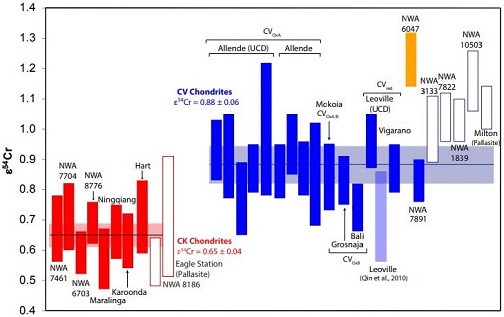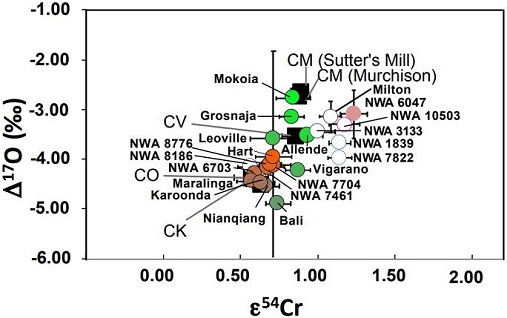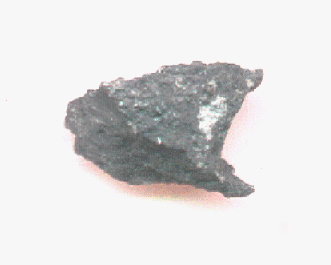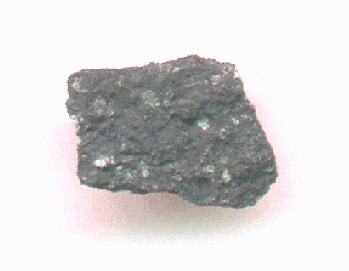NingQiang
CK3.3
Fell June 25, 1983
32° 55.5′ N., 105° 54.4′ E. At 7:00 in the evening, this unique carbonaceous chondriteCarbonaceous chondrites represent the most primitive rock samples of our solar system. This rare (less than 5% of all meteorite falls) class of meteorites are a time capsule from the earliest days in the formation of our solar system. They are divided into the following compositional groups that, other than Click on Term to Read More fell in Ningqiang County, Shaanxi Province, The People’s Republic of China. Four stones were recovered weighing 0.35, 0.38, 0.78, and 3.1 kg for a total of 4.61 kg. The curator for the majority of the material is the Zijin Shan Observatory, Academia Sinica, in Nanjing, People’s Republic of China.

click on photo for a magnified view O–Cr Diagram For CV and CK Chondrites
CK: orange shades; CV: green shades; Achondrites: open

click on photo for a magnified view Diagrams credit: Yin and Sanborn et al., 50th LPSC, #3023 (2019)
A unique dark inclusion (DI) was discovered in Ningqiang which represents some of the most pristine nebular material ever studied (Zolensky et al., 2003). It comprises two lithologies, both of which consist of µm-sized olivine and pyroxeneA class of silicate (SiO3) minerals that form a solid solution between iron and magnesium and can contain up to 50% calcium. Pyroxenes are important rock forming minerals and critical to understanding igneous processes. For more detailed information, please read the Pyroxene Group article found in the Meteoritics & Classification category. Click on Term to Read More crystals, but in only one are the silicates rimmed by amorphousMaterial without the regular, ordered structure of crystalline solids. Amorphous substances, like glass, lack a definite repeating pattern in their atomic structures (crystallinity). There may be small regions of order, but, overall there is disorder. Click on Term to Read More to microcrystalline material. These rims are thought to have formed through irradiation by bipolar outflows or FU-orionis flares from the nascent SunOur parent star. The structure of Sun's interior is the result of the hydrostatic equilibrium between gravity and the pressure of the gas. The interior consists of three shells: the core, radiative region, and convective region. Image source: http://eclipse99.nasa.gov/pages/SunActiv.html. The core is the hot, dense central region in which the, and in fact, this rim material is the carrier for Ar-rich, heavy primordial noble gasesElement occurring in the right-most column of the periodic table; also called "inert" gases. In these gases, the outer electron shell is completely filled, making them very unreactive. Click on Term to Read More that were produced in a plasmaFourth state of matter: a gas in which many or most of the atoms are ionized. In the plasma state the atoms have split into positive ions and negative electrons, which can flow freely, so the gas becomes electrically conducting and a current can flow. Click on Term to Read More (Nakamura et al., 2003). In addition, an amorphous carbon phase in this DI contains both the dominant ‘Q’ noble gases (for ‘quintessence’) and exotic ‘HL’ noble gases (enriched in both heavy and light isotopes). This porous carbonaceous host phase for the Q-gases has been characterized by Amari et al. (2013) as nanoscale graphene platelets (see photo below). An in-depth investigation into the carbonaceous carrier of the Q-phase was conducted by Fisenko et al. (2018) utilizing the L4 chondrite Saratov. They contend that the carrier of the Q-gases is a nongraphitizing carbon phase present as curved, few-layer, graphene-like sheets which were likely formed in the protoplanetary nebula. The DI in the Ningqiang chondrite must have been incorporated after parent body aqueous alteration processes were complete and subsequent to partial annealing, since noble gases would have been quickly lost from host minerals through such oxidizingOxidation and reduction together are called redox (reduction and oxidation) and generally characterized by the transfer of electrons between chemical species, like molecules, atoms or ions, where one species undergoes oxidation, a loss of electrons, while another species undergoes reduction, a gain of electrons. This transfer of electrons between reactants Click on Term to Read More alteration processes (Yamamoto et al., 2006).

Photo and caption: Sachiko Amari et al., The Astrophysical Journal, vol. 778, #1 (2013)
High-resolution aberration-corrected scanning transmission electron microscopy (STEM) image shows planar carbon ring structures
inside graphene platelets in Q from acid-resistant residue of the L4 Saratov meteorite. Arrows indicate curled edges of graphene platelets. Most of the CAIs in Ningqiang contain Na-rich nepheline aggregates replacing meliliteGroup of minerals found in the CAIs of meteorites such as CV chondrites. Melilite consists almost exclusively of the binary solid solution gehlenite (Ca2Al2SiO7) – åkermanite (Ca2MgSi2O7). The melilite in CAIs is closer to gehlenite in composition. The first-formed (highest-temperature) melilite crystallizing from a melt is relatively aluminum-rich and becomes progressively Click on Term to Read More, which is thought to have occurred by a hydrothermal process (Sugita and Tomeoka, 2008). Moreover, the Ningqiang matrix has a higher Na content than CV3 matrices and is composed of two components derived from distinct parent body reservoirs: the first component consists of sub-µm-sized magnesian olivine with included nepheline (also derived from the reservoir from which the nepheline-containing CAIs originated), while the second component consists of larger than µm-sized ferroan olivine only rarely associated with nepheline, but does contain abundant grains of FeS and magnetite. Trace amounts of the secondary alteration minerals sodalite and nepheline have been discovered in many components of Ningqiang. Considering the high abundance of sodalite observed in one DI relative to the expected abundance in the more porous matrix material, and understanding that the O-isotopic plot falls along the CCAM line, Wang and Hsu (2008, 2009) concluded that the sodalite and nepheline were formed in a nebular environment prior to parent body accretionAccumulation of smaller objects into progressively larger bodies in the solar nebula leading to the eventual formation of asteroids, planetesimals and planets. The earliest accretion of the smallest particles was due to Van der Waals and electromagnetic forces. Further accretion continued by relatively low-velocity collisions of smaller bodies in the Click on Term to Read More. Nakashima et al. (2008) presented further isotopic evidence indicating that nebular alteration processes were responsible for the formation of these secondary mineralMineral that forms through processes such as weathering, and in the case of meteorites can also include pre-terrestrial alteration. Secondary minerals in meteorites that formed during terrestrial weathering include oxides and hydroxides formed directly from metallic Fe-Ni by oxidation, phosphates formed by the alteration of schreibersite, and sulfates formed by Click on Term to Read More phases in Ningqiang. It is thought likely that sodalite and nepheline formation occurred through an alkali–halogenReactive nonmetal that is in Group 17 (VIIA) of the periodic table: F, Cl, Br, I and At. All of halogen elements are strongly electronegative. Click on Term to Read More metasomatic process involving anorthiteRare compositional variety of plagioclase and the calcium end-member of the plagioclase feldspar mineral series with the formula CaAl2Si2O8. Anorthite is found in mafic igneous rocks such as anorthosite. Anorthite is abundant on the Moon and in lunar meteorites. However, anorthite is very rare on Earth since it weathers rapidly Click on Term to Read More prior to its accretion to the parent body. In further studies of Ningqiang, Matsumoto et al. (2014) concluded that the fine-grained nepheline and sodalite now present in the matrix was initially formed through Na–Fe metasomatism and replacment of precursor chondrules and CAIs in the early stages of parent body formation. Thereafter, disaggregation of the altered chondrules, CAIs, and host matrix occurred, and the nepheline/sodalite was transported in a fluid and incorporated into the matrix grains of the meteorite source rock prior to final lithification. Matsumoto et al. (2017) suggest that the low abundance of CAIs and the small size and irregular shape of chondrules in Ningqiang, relative to typical CV3 chondrites, can be attibuted to this late-stage process. Presolar silicate and oxide grains as well as grains exhibiting O-isotopic anomalies have been identified in Ningqiang matrix areas, with the abundance in one area reaching 230 ppmParts per million (106). Click on Term to Read More (Zhao et al., 2011). Most of these grains have 17O enrichments and likely formed around low- to intermediate-mass red giantGiant and highly luminous red star in the later stages of stellar evolution after it has left the main sequence. These red stars have a relatively cool surface whose core has burned most of its hydrogen. Red giants lose parts of their atmospheres and thus provide new elements into interstellar Click on Term to Read More branch stars and asymptotic giant branchPath on the Hertzsprung-Russell diagram corresponding to the changes that a star undergoes after He burning ceases in the core. At this stage, the C core shrinks and drives the expansion of the envelope, and the star becomes a red supergiant. Click on Term to Read More stars; however, a small number of the grains probably formed in supernovae. These presolar grainsMineral grains that formed before our solar system. These tiny crystalline grains are typically found in the fine-grained matrix of chondritic (primitive) meteorites. Most grains probably formed in supernovae or the stellar outflows of red giant (AGB) stars before being incorporated in the molecular cloud from which the solar system Click on Term to Read More are all enriched in Fe through a secondary Fe–alkali–halogen metasomatic process. A Chinese–American team of scientists from the Chinese Academy of Sciences and Arizona State University have identified two short-lived radionuclides in Ningqiang—60Fe and 36Cl—both of which likely formed inside an earlier generation of massive stars, perhaps attaining 30–60× the mass of the Sun. Rapidly expanding UV radiation from such a massive starSelf-luminous object held together by its own self-gravity. Often refers to those objects which generate energy from nuclear reactions occurring at their cores, but may also be applied to stellar remnants such as neutron stars. could have produced a shock waveAbrupt perturbation in the temperature, pressure and density of a solid, liquid or gas, that propagates faster than the speed of sound. that triggered the formation of low-mass stars like the Sun. The final life stage of such a massive star is a supernovaStellar explosion that expels much or all of the stellar material with great force, driving a blast wave into the surrounding space, and leaving a supernova remnant. Supernovae are classified based on the presence or absence of features in their optical spectra taken near maximum light. They were first categorized Click on Term to Read More, which would have enriched our protoplanetary diskFlattened and rotating disk of dense gas and dust/solids orbiting a young star from which planets can eventually form. Click on Term to Read More with the short-lived radionuclides that we observe. However, it was recognized that a significant probability exists for such an event to disrupt the presolar nebula instead of causing its gravitational collapse. An alternative model was presented by Sahijpal and Gupta (2007) in which low-mass star formation occurs first as a result of local density fluctuations, and thereafter, a massive star (>40 M⊙) is formed within ~25 parsecs, perhaps through rapid accretion or through stellar mergers. This massive star is conjectured to have undergone coreIn the context of planetary formation, the core is the central region of a large differentiated asteroid, planet or moon and made up of denser materials than the surrounding mantle and crust. For example, the cores of the Earth, the terrestrial planets and differentiated asteroids are rich in metallic iron-nickel. Click on Term to Read More collapse and transition into a supernova within a short interval of ~3–5 m.y., injecting short-lived nuclides into the existing protoplanetary disk(s). This scenario is also consistent with the finding that the earliest CAIs contain no 26Al. Bizzarro et al. (2007) found that the differentiated meteorites do not contain 60Fe, but that later-formed chondrites do, and that all of the meteorite types do contain 26Al. They believe the radiometric evidence indicates that 26Al was infused into the local nebula very early through stellar winds from a nearby massive star. Sahijpal and Gupta (2009) suggest that this massive star belonged to a common stellar cluster and was located ~3.5 parsecs from the protosun. Injection of radionuclides by this massive star into the presolar nebula could have occurred during a Wolf-Rayet stage or during a core collapse supernova ~1 m.y. after the onset of planetesimal agglomerationProcess of collecting in a jumbled cluster. In relation to meteorites, agglomeration refers to the early accretion of chondrules, refractory inclusions and silicate matrix material to form chondritic clusters. Click on Term to Read More, after which 26Al became homogeneously mixed throughout the nebula. The stellar winds from the massive star could even be primarily responsible for the initial collapse of the protosolar disk. Only after the supernova explosion occurred was the 60Fe released from the massive star’s interior and injected into the dust of newly accreting chondritic parent bodies. For additional information on the studies of Bizzarro et al. (2007) read the PSRD article by G. Jeffrey Taylor: ‘The Sun’s Crowded Delivery Room‘, July 2007. Ningqiang has had a variable history with its classification, at one time or another being associated with the CV, CK, and CO groups, usually as an anomalous member, or otherwise considered to be ungroupedModifying term used to describe meteorites that are mineralogically and/or chemically unique and defy classification into the group or sub-group they most closely resemble. Some examples include Ungrouped Achondrite (achondrite-ung), Ungrouped Chondrite (chondrite-ung), Ungrouped Iron (iron-ung), and Ungrouped Carbonaceous (C-ung). Click on Term to Read More (G. Kallemeyn, 27th LPSC, #1318 [1996]). Other analyses indicating lower than usual refractory lithophile abundances led to the general conclusion that Ningqiang would be best classified as an ungrouped C3 chondrite (e.g., Wasson et al., 2013). More recent isotopic analyses conducted by Yin and Sanborn (2019) establish a CK group membership for Ningqiang. The photo shown above is a 1.2 g interior fragment of Ningqiang, while the photo below shows a prominent CAISub-millimeter to centimeter-sized amorphous objects found typically in carbonaceous chondrites and ranging in color from white to greyish white and even light pink. CAIs have occasionally been found in ordinary chondrites, such as the L3.00 chondrite, NWA 8276 (Sara Russell, 2016). CAIs are also known as refractory inclusions since they Click on Term to Read More exposed inside of a broken edge.








